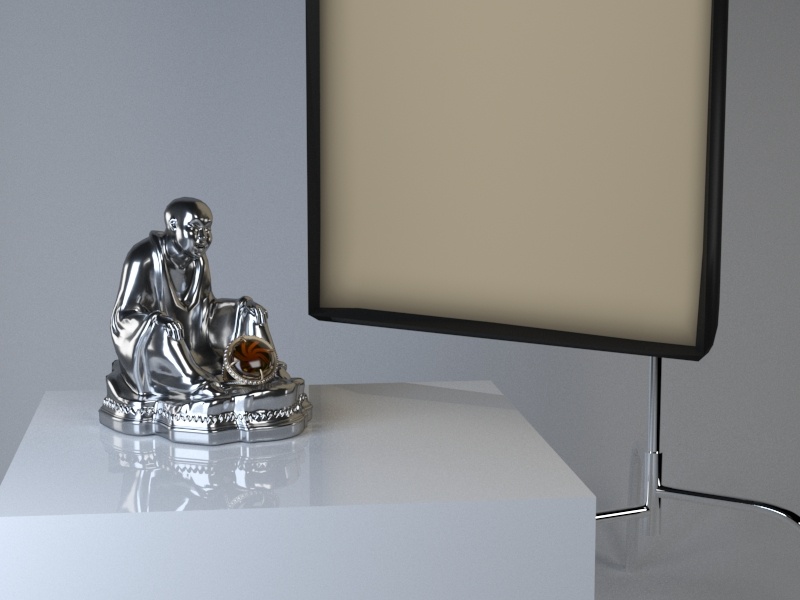This page provides information on the V-Ray Light Emitting Material.
Overview
The VRayLightMtl is a special material provided with the V-Ray renderer. This material is generally used for producing self-illuminated surfaces. It also allows for faster rendering rather than with a Standard 3ds Max material with self-illumination enabled.
It also allows to turn an object into an actual light source.
© Jonathan Evans
Parameters
Color – Specifies the self-illumination color of the material.
Multiplier – Specifies a multiplier for the Color. Note that this does not affect the texture map, if specified. For more information, see Default Color and Multiplier Values example below.
Opacity – Specifies a texture to use as opacity for the material. Note that making the material less opaque does not affect the intensity of the self-illumination color. This is so that perfectly transparent materials that nevertheless still emit light can be created.
VRayLightMtl supports color opacity. This means that it uses the "color" output of textures rather than their "mono" output, in difference from the Opacity slot of VRayMtl materials.
Emit light on back side – When enabled, the object emits light from its back side as well. When disabled, the material is rendered as black on the back sides.
Compensate camera exposure – When enabled, the intensity of the light material is adjusted to compensate the exposure correction from the physical camera.
Multiply color by opacity – When enabled, the color of the light material is multiplied by the opacity texture. Otherwise, the color and opacity act independently (so-called additive transparency).
Displace – Allows you to add a displacement map to the V-Ray Light Material.
Texture – Specifies a texture map to use for the self-illumination color. For more information, see Texmap example below.
Direct Illumination
The controls in this section allow you to turn the objects with this VRayLightMtl material into actual direct mesh light sources. The effect is equivalent to creating a VRayLight in Mesh mode for the same object. The controls in this section are intentionally simple; if you need more control over the light source (exclude objects from illumination etc.), it is better to use a VRayLight instead.
There are currently some restrictions on using these options. For more details, please see the Notes section below.
On – When enabled, direct illumination is turned on. Any object to which this material is assigned turns into a light source, similar to a VRayLight Mesh light. Note that this currently does not work if the material is inside a Multi/Sub-object material.
Cutoff – Specifies a threshold for the light intensity, below which the direct illumination is not computed. This can be useful in scenes with many light sources, where you want to limit the effect of the lights to some distance around them. Larger values cut away more from the light; lower values make the light range larger. If you specify 0.0, the light will be calculated for all surfaces. This parameter is not available when the renderer is set to GPU.
Example: GI
Here is a scene rendered with the default VRayLightMtl. The emitting surface of the soft-box has VRayLightMtl applied. These examples demonstrate how the material behaves in V-Ray, and how its parameters influence the look of the final results.
Example: Multiplier
As you can see, we have decreased the intensity of the Ambient lights, to make the effect of the multiplier more visible.
Slide to turn on GI and ambient lighting.
Example: Emit light on back side
This example shows the ability of the VRayLightMtl to emit light from the back side, as you can see in the mirror behind the lighting disk.
Example: Emit light on the back side (Multiplier)
This example shows the effect of the multiplier value when the Emit light on back side is on.
Example: Compensate camera exposure
This example shows the effect of the compensate camera exposure option. When enabled, the intensity of the light material is adjusted to compensate the exposure correction from the physical camera.
Example: Texture
Specifies a texture map to use for the self-illumination color. This example shows the effect of effect of the multiplier when the texture option is enabled.
Notes
- You can use the VRayLightMtl as a light source assigned to an object. Increasing the multiplier affects the GI solution and produces more light. Note that over bright colors may look the same as pure white but the GI results are different. For more information see the Examples section.
- If you know the photometric power of a self-illuminated object in lumens (e.g. 1700 lm for a 100-watt bulb) you can calculate the multiplier for VRayLightMtl if you divide the lumens by the surface area of the object in meters (the 3ds Max Measure utility can be used for this), provided that the self-illuminated color is pure white.
- The direct illumination options will only work properly if VRayLightMtl is the only material applied to the object. It will not work if the material is part of a complex material like Multi/sub-object or VRayBlendMtl. This restriction will probably be removed in a future release.
- The direct illumination option does not work properly if the object with the VRayLightMtl has motion blur. This will be corrected in a future release. You can use a VRayLight in "mesh" mode instead.







































